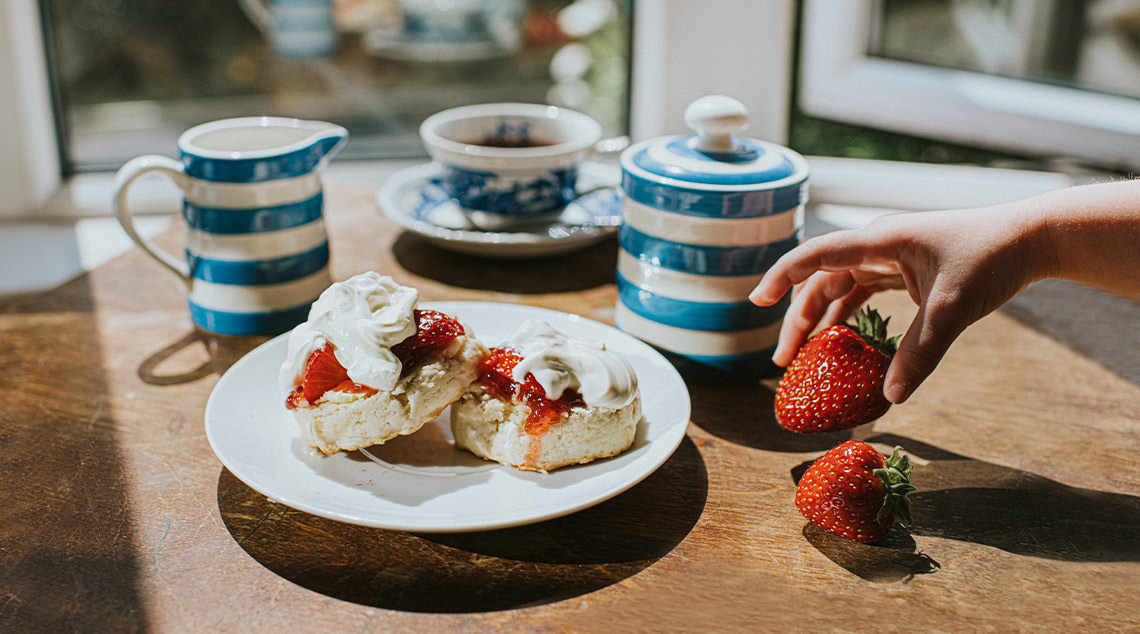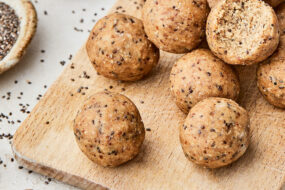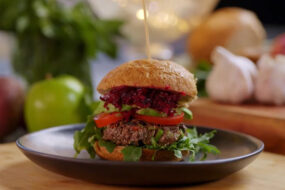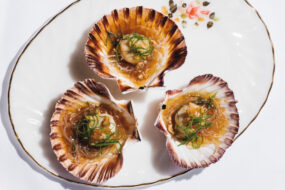Your ultimate guide to baking perfect homemade scones
The art of baking light, fluffy and buttery scones has been perfected over centuries. Here are the experts’ top tips, plus an easy recipe to try at home.
No cup of tea is complete without a delicious scone on the side.
These inexpensive, versatile and iconic tea-time delights are easy to make — and with the right scone recipe can be baked to perfection at home.
Scones have a long history, and date back to the early 1500s.
“Scones originated in Scotland and were originally made using oats,” executive pastry chef Markus Bohm, of The Langham in Melbourne, says.
“Around 1840, scones became part of a fashionable ritual of afternoon tea in England.”
Whether to bring a slice of history to your next tea party or reinvent a classic favourite with sweet or savoury additions, follow these expert tips to nail the perfect scone.
On this page:
- What equipment do you need to make scones?
- What types of scones can you make?
- How to make lemonade scones
- Should you use butter or margarine to make scones?
- How do you serve scones?
- How to store scones after baking
- How to make the perfect scone
- Classic scone recipe
What equipment do you need to make scones?
You can put away the fancy mixer and other kitchen gadgets because handmade scones are best, according to seasoned scone baker and Quairading Country Women’s Association branch president Elaine Johnson.
“I’ve got the world’s best food processor, but scones always come out nicer when you make them by hand,” Elaine says.
“It’s to do with the heat of your hands rubbing the fat into the flour, as it bursts the starch cells and makes them rise better.”
Elaine says a good scone should be light, fluffy, easy to break in half and spread with butter.
This is easier to achieve with a handmade dough.
But if you do choose to mix with a food processor, Markus says to proceed with care.
“It’s nice to use a food processor, but you have to be careful not to overmix the dough,” he says.
What types of scones can you make?
While the plain scone remains a staple, sweet and savoury variations have emerged over the years.
“A bit of mixed fruit and brown sugar creates a really nice flavour,” Elaine says.
On the savoury side, Elaine recommends the cheese scone — her personal favourite.
She suggests adding cheese to the mixture after rubbing fat into the flour, but before adding the eggs and milk.
Pumpkin scones are another popular spin-off.
“There are heaps of pumpkin scone recipes out there and one shortcut is using a can of pumpkin soup instead of traditionally made pumpkin scones where you’ve cooked the pumpkin and mashed it up,” Elaine says.
And if you’re feeling creative, Markus says scones can work with a range of sweet additions.
“You can add different dried fruits like blueberry, sun-dried cherries, or cranberries and orange peel,” he says.
“You might also add chocolate chips, different kinds of nuts, or infuse the milk you are using for the recipe with saffron and add this to your dough mix.”
How to make lemonade scones
If you’re baking a sweet type of scone, lemonade can add extra sweetness and help aerate the dough to encourage a fluffy finish.
“Lemonade is just another way of making the dough puff up, and it’s easy to add the lemonade to your flour and mix it up.” Elaine says.
“Lemonade scones are quite nice, there’s nothing wrong with them, but they don’t come out as light and fluffy as the traditionally made scone and they probably wouldn’t keep as long.”
Should you use butter or margarine to make scones?
Both butter and margarine are suitable fat sources for making scones; however, the Country Women’s Association of Western Australia recommends using butter.
How do you serve scones?
Classic scones
What comes first, the cream or the jam? According to Markus, English tradition says it can be either.
“Much debate surrounds the ‘correct’ way to eat a scone,” he says.
“In Cornwall, jam is added first to allow it to sink into the warm scone before clotted cream is added on top.
“In Devon, it’s the other way around.”
Butter can also be used instead of clotted cream, or you can place a lighter whipped or chantilly cream on top.
Savoury scones
Elaine recommends topping savoury scones with butter or tomato and extra cheese.
“If the scones are a couple of days old or you want something quick and tasty, you can pop cheese scones in the oven with a bit of cheese and tomato on top,” she says.
How to store scones after baking
Scones will stay fresh for a couple of days when stored at room temperature and in an airtight container in the pantry.
After that, it’s best to refrigerate or freeze them.
“I tend to freeze them,” Elaine says.
“I cut them in half and put them in the freezer in little bags so they’re easy to take out and microwave whenever I need.”

How to make the perfect scone
A recipe will give you the list of ingredients and steps, but only the experts can spill the secrets to baking perfect scones.
We asked Markus and Elaine to share their top tips for scone success:
Rub butter into the flour
“First, the butter needs to be cold and cut into small cubes,” Markus says.
“Rub butter cubes into the flour until it (the butter) is completely absorbed.
“The whole mix should be quite powdery before you add the other ingredients.”
Use a knife to mix the dough
Elaine mixes with her hands, then with a knife, then with her hands again.
“After rubbing the fat into the flour, mix with a knife first so you don’t lose any air out of your mixture,” she says.
“Once the mixture comes away from the side of the bowl and starts to join together, I put my hands back in and knead it, then put it out on a floured board.”
Don’t overwork the dough
When cutting round scones, you’re bound to have leftover dough scraps you can roll out again.
But Markus says not to knead this scrap dough.
“Make sure you just push the scraps together to roll it out, don’t knead it again,” he says.
“That’s how you overwork the dough.”
Add flour to soggy dough
“Some people accidentally make their dough quite sticky but don’t add more flour to balance it out,” Elaine says.
This can create a soggy scone. If your dough becomes sticky and hard to roll out, Elaine suggests adding more flour to bring it back to a normal texture.
Punch your dough
As strange as it sounds, Elaine swears by this step to get extra fluffy scones.
“When I make scones, I punch the dough down after I’ve kneaded everything,” she says.
“Other people might roll it out or pat it gently so as to not interfere with it but my mother always taught me that if you punch the dough down, it’ll always pop up and you’ll have really nice scones.
“That’s what I’ve always done, and my scones seem to come out twice as high as everybody else’s.”
Classic scone recipe
Start with this easy, time-tested recipe from The C.W.A. Cookery Book & Household Hints to recreate classic scones, or use it as a base for your sweet and savoury scone creations.
Ingredients
500g self-raising flour
1 tbsp full cream powdered milk
1 tsp salt
60g butter
375ml water
Method
Step 1.
Preheat the oven to 250℃.
Step 2.
Sift all dry ingredients into a bowl and rub in the butter.
Step 3.
Stir in the water and turn the dough out onto a lightly floured board.
Step 4.
Knead the dough lightly until smooth.
Step 5.
Roll the dough from the centre outwards and cut it into rounds.
Step 6.
Cook the scones in the oven for 12-15 minutes.
Edited extract from The C.W.A. Cookery Book & Household Hints, 54th Edition (1993), by Country Women’s Association.
More sweet treat recipes and baking tips:
- Recipe: Chamomile tea cake
- Recipe: Low-fat oatmeal biscuits
- Recipe: Gluten-free Anzac biscuits
- Baking for special dietary needs? Try these easy ingredient substitutes
Written by Hayley Hinze.






